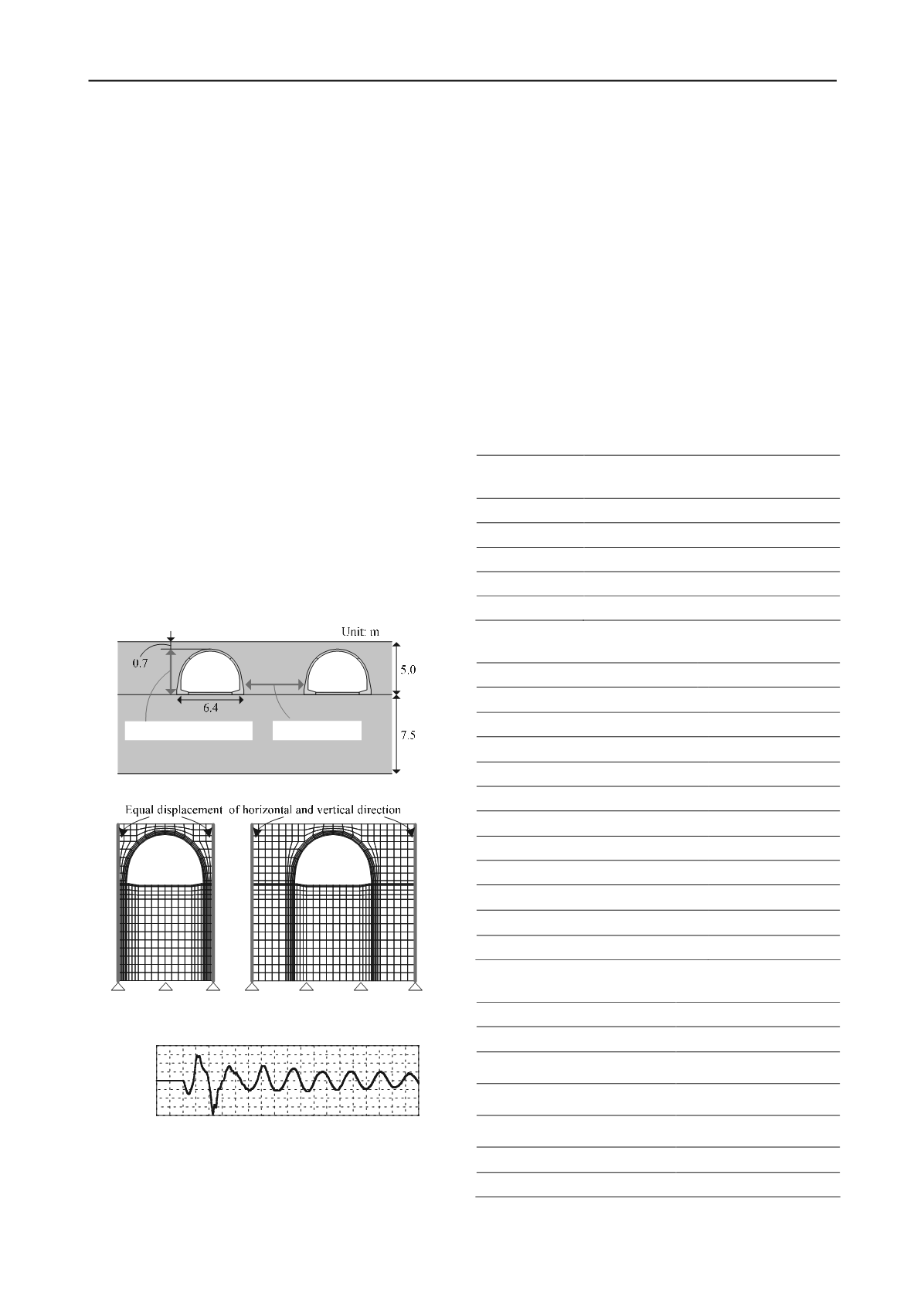
1592
Proceedings of the 18
th
International Conference on Soil Mechanics and Geotechnical Engineering, Paris 2013
load alleviation of the foundation ground. This results into the
unit interval being smaller than the case where usual fill
material is used. Though, the purpose of this study is to examine
the difference of the dynamic behavior by unit interval, usual
sandy material is used for fill ground. Unit interval L between
the precast arches was expressed as a function of the culvert
height H. Results of the case with consecutive arch culverts
were compared to cases of single arch culvert setting alone. The
examination cases are shown in Table 1. In the cases of multi-
arch culverts embankment, since several precast arch culverts
are set up continuously in the in-situ construction, 1 unit of arch
culvert was modeled and both sides of analytical domain were
configured equal displacement condition of horizontal and
vertical direction. Moreover, the boundary on the bottom area is
fixed on all directions. The analysis mesh of Case-1,3 and
boundary condition were as shown in Figure 3. On the other
hand, in the case of single arch culvert, the width of analytical
domain is wide enough (100 m) and boundary condition is same
as other cases. The input ground motions used in this study is
the time history of acceleration measured in the centrifuge
model test when 1 Hz sin wave was inputted by controlling the
displacement of vibration table. The input ground motions
shown in Figure 4 are applied at the bottom boundary. The time
interval of calculation is 0.01 seconds.
1.2
Modeling of ground
The constitutive model for foundation ground and filling
adopted in the present study is subloading
t
ij
model (Nakai and
Hinokio, 2004). This model was proposed based on the concept
Figure 2. Dimension of multi-arch culverts
(a) Case-1 (
L
=0.25
H
)
(b) Case-4 (
L
=1.50
H
)
Figure 3. Analytical mesh and boundary condition
-400
-300
-200
-100
0
100
200
300
400
0 1 2 3 4 5 6 7 8 9 10
Time [sec]
Acceleration [gal]
Figure 4. Input wave
of SMP (Spatially Mobilized Plane (Matsuoka and Nakai,
1974)), in which the influence of the intermediate principal
stress can be properly evaluated. Furthermore this model can
describe the dependence of the direction of plastic flow on the
stress paths, density and confining pressure on the deformation
and strength of soils. Same Properties was used for foundation
ground and filling as shown in Table 2. The damping coefficient
of both ground are assumed as 5%.
1.3
Modeling of arch culvert
In-situ precast arch culverts are made by joining several precast
sections and its joints are connected using pre-stressed concrete
wire. The joints stiffness is somewhere between rigid and hinge.
However, the arch culvert model in this study was made as an
all-in-one design structure. While modeling of structure,
nonlinearity of concrete was also considered. For culvert
concrete, nonlinear moment-curvature relation was simulated
using the AFD model (Zhang and Kimura, 2002), which
considered the axial-force dependency according to variable
axial force of the structure. The parameter of arch culvert is
Table 1. Examination cases
Case
Unit interval
(Number of node: N, Number of element: E)
Case-1
L=0.25H (N:1478 , E:642)
Case-2
L=0.50H (N: 1578, E:690)
Case-3
L=1.00H (N: 1778, E:786)
Case-4
L=1.50H (N: 1978, E:882)
Case-Single
∞ (N:6278 , E:2946)
Table 2. Property of embankment and foundation ground
Constitutive model
Subloading t
ij
model
Unit weight
(kN/m
3
)
15.76
Principal stress ratio at critical sate R
cs
3.20
Poisson’s ratio
0.30
Coefficient of earth pressure at rest K
0
0.42
Void ratio e
0
0.65
(stress-dilatancy)
2.00
a (ANN) parameter
500
OCR
1.20
Compression index
0.012
Swelling index
0.0025
Damping coefficient h
0.05
Table 3. Parameter of concrete
Constitutive model
AFD model
Unit weight
(kN/m
3
)
19.35
Young’s modulus E
(kN/m
2
)
2.07
×
10
7
Compressive strength f
c
(kN/m
2
)
4.92
×
10
4
Tensile strength f
t
(kN/m
2
)
5.76
×
10
3
Poisson’s ratio
0.18
Damping coefficient h
0.02


